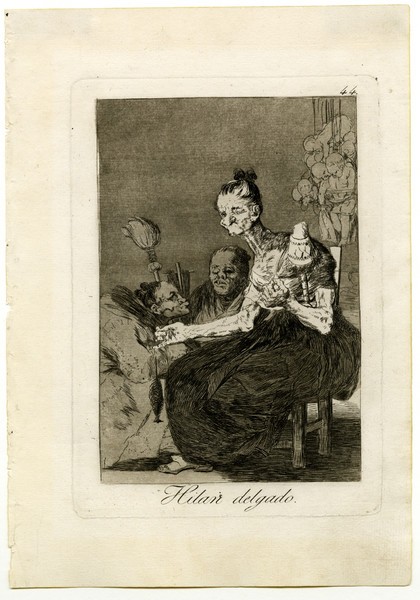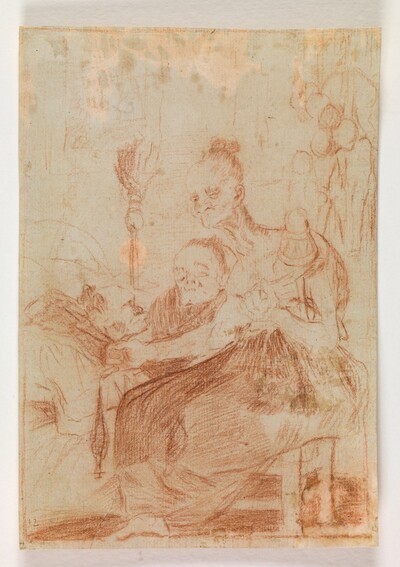- Cronología
- Ca. 1797 - 1799
- Dimensiones
- 219 x 153 mm
- Técnica y soporte
- Aguafuerte, aguatinta, punta seca y buril
- Reconocimiento de la autoría de Goya
- Undisputed work
- Ficha: realización/revisión
- 16 Dec 2010 / 29 May 2024
- Inventario
- 225
Hilan delgado. (at the bottom left-hand corner)
44. (in the upper right-hand corner)
See Francisco de Goya y Lucientes, Painter.
A preparatory drawing of this engraving is in the Prado Museum.
Three old women with gaunt, caricatured faces are depicted in this engraving. One of them, the one in the foreground, is seated on a chair and is spinning. Somewhat further back, an older woman with a deformed face is also seated and gazes into the void with an absorbed air. Finally, a third female figure appears in profile, holding a broom in one of her hands. In the background, on the right-hand side of the engraving, there are ropes hanging from the ceiling from which children, probably foetuses, are hanging.
The upper part of the body of the first old woman is intensely illuminated and contrasts with the dark atmosphere created by the use of two aquatints. The drypoint is used to accentuate the yarn and burin on the neck and back of the spinner in the foreground, as well as the legs of the chair.
Three manuscripts on The Caprices coincide in explaining this engraving as a depiction of a henchwomen plotting something, although they could also be witches. With this print Goya thus began the series of images devoted to witchcraft and superstition. This theme had already been dealt with by the artist in the series of paintings he produced for the Duke and Duchess of Osuna around 1798. In one of them, entitled Aquelarre, Goya depicted human foetuses hanging, in this case from a rod, which are also present in Caprice no. 43, The Sleep of Reason Produces Monsters. It is possible that they play an important role in the incantations that these women prepare or "spin", as the title of the engraving suggests. It has also been suggested that the three women are the Fates - Nona, Decima and Morta - who weave the thread of life, probably of the children hanging from the ceiling, from birth to death.
If we relate this engraving to the following one, no. 45, Much to suck, especially with the explanations provided in the manuscripts, we can conclude that the three old women are engaged in abortive practices. It is possible that this has to do with the use of children's corpses in spells or witchcraft.
The plate is in poor condition, with the aquatint practically missing ( National Chalcography, no. 215).
-
Goya. Gemälde Zeichnungen. Graphik. TapisserienKunsthalle BaselBasle1953from January 23th to April 12th 1953cat. 231
-
Goya. La década de Los CaprichosMadrid1992organized by Real Academia de Bellas Artes de San Fernando sponsored by Fundación Central Hispano, Madrid, consultant editor Nigel Glendinnig. From October 26th 1992 to January 10th 1993cat. 55
-
GoyaNationalmuseumStockholm1994consultant editors Juan J. Luna and Görel Cavalli-Björkman. From October 7th 1994 to January 8th 1995cat. 65
-
Francisco de GoyaMuseo d'Arte ModernaLugano1996exhibition celebrated from September 22nd to November 17th.cat. 44, p.71
-
Francisco Goya. Sein leben im spiegel der graphik. Fuendetodos 1746-1828 Bordeaux. 1746-1996Galerie KornfeldBern1996from November 21st 1996 to January 1997cat. 50
-
Goya e la tradizione italianaFondazione Magnani RoccaMamiano di Traversetolo (Parma)2006consultant editors Fred Licht and Simona Tosini Pizzetti. From September 9th to December 3th 2006cat. 44, p.156
-
Goya. Opera graficaPinacoteca del Castello di San GiorgioLegnano2006exhibition celebrated from December 16th 2006 to April 1st 2007p.34
-
Goya et la modernitéPinacothèque de ParisParís2013from October 11st 2013 to March 16th 2014cat. 196
-
London2015cat. 30
-
Expérience GoyaLille2021cat. 59
-
2022
-
Goya engravings and lithographs, vol. I y II.OxfordBruno Cassirer1964p.117, cat. 79
-
Vie et ouvre de Francisco de GoyaParísOffice du livre1970p.181, cat. 539
-
Goya, la década de los caprichos: dibujos y aguafuertesMadridReal Academia de Bellas Artes de San Fernando1992pp.92-93, cat. 55
-
Catálogo de las estampas de Goya en la Biblioteca NacionalMadridMinisterio de Educación y Cultura, Biblioteca Nacional1996p.97, cat. 133
-
El libro de los caprichos: dos siglos de interpretaciones (1799-1999). Catálogo de los dibujos, pruebas de estado, láminas de cobre y estampas de la primera ediciónMadridMuseo Nacional del Prado1999pp.246-249
-
ParísPinacoteca de París2013p. 262
-
LondonThe Courtauld Gallery2015p. 139
-
Goya. In the Norton Simon MuseumPasadenaNorton Simon Museum2016pp. 42-75
-
Expérience Goya (cat. expo)LilleRéunion des Musées Nationaux2021p. 118
-
Museo de Bellas Artes de Badajoz y Diputación de Badajoz2022p. 43

